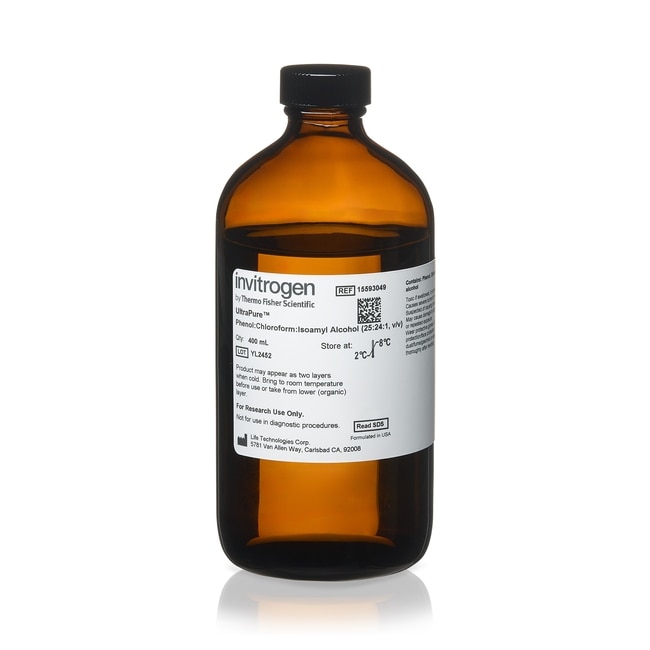Search Thermo Fisher Scientific

Fenol UltraPure™; cloroformo; alcohol isoamilo (25:24:1, v/v)
| Número de catálogo | Cantidad |
|---|---|
| 15593049 | 400 mL |
| 15593031 | 100 mL |
Uso de fenol/cloroformo/alcohol isoamílico
Cuando se extraen mezclas con fenol/cloroformo/alcohol isoamílico, las proteínas se desnaturalizan y se recogen en la fase orgánica o en la interfase, mientras que los ácidos nucleicos permanecen en la fase acuosa. El fenol/cloroformo/alcohol isoamílico UltraPure™ no contiene conservantes. Se envasa en un gas inerte en botellas de color ámbar revestidas de plástico y resistentes a roturas.
Pruebas de rendimiento y calidad
El aspecto de la solución se evalúa a temperatura ambiente. No se ha detectado ninguna actividad de ribonucleasa (ARNasa) ni desoxirribonucleasa (ADNasa).
Customers who viewed this item also viewed
Documentos y descargas
Certificados
Hojas de datos de seguridad
Product Information
Preguntas frecuentes
Phenol extraction of proteins:
Phenol extraction is frequently used to remove proteins from nucleic acid solutions. A common protocol is to add an equal volume of buffer-saturated phenol or phenol:chloroform:isoamyl alcohol (25:24:1, v/v/v) to an aqueous nucleic acid solution, vortex, and centrifuge at 14,000 x g for 1 min to separate the phases.
Studies at Thermo Fisher Scientific have shown that the concentration of NaCl in the aqueous solution should not exceed 0.5 M for good recovery of DNA. Residual phenol can be removed from the aqueous phase by extraction with an equal volume of chloroform or ether. After extraction, DNA is usually precipitated with ammonium acetate and ethanol as described in another protocol on this server. Ref. Karger, B. D. (1989) FOCUS 11, 14.
A good source of general information on the properties of phenol can be found in Wallace, Donald M. “Large and Small-Scale Phenol Extractions”. Methods in Enz. Volume 152 guide to Molecular Cloning Techniques. 1987. Academic Press, Inc. Berger and Kimmel, eds. Chap.4, pg 33-41.
(a) At pH 5 to 6 DNA is selectively retained in the organic phase and interphase, leaving RNA in the aqueous phase. Therefore a pH greater than 7 is needed if DNA is to be extracted.
(b) At pH values below 7.6, poly A+ RNA is lost to the organic phase if chloroform is not present.
(c) Optimal RNA yields in phenol extraction are obtained if the salt concentration is less than 0.15 M NaCl. Salt concentration in the sample is not a factor for larger DNA molecules.
To store RNA after extraction use DEPC-treated water.
Below is a commonly used protocol:
(1) Add an equal volume of buffer-saturated phenol or phenol:chloroform:isoamyl alcohol (25:24:1, v/v/v) to an aqueous nucleic acid solution. Note: for RNA solutions, acid-phenol is recommended.
(2) Vortex, and centrifuge at 14,000 x g for 1 min to separate the phases.
(3) Residual phenol can be removed from the aqueous phase by extraction with an equal volume of chloroform or ether.
(4) After extraction, DNA/RNA is usually precipitated with ammonium acetate and ethanol.
Partitioning of the nucleic acids in phenol is pH dependent. At pH 7.0 or higher, both DNA and RNA partition into the aqueous phase. At an acidic pH (below 7.0) DNA is denatured and will move into the organic phase, but the RNA remains in the aqueous phase. The mixture should be adjusted to at least pH 7.4 for work with DNA.
Using urea during phenol extraction denatures the protein associated with the DNA and the proteins that bind the genomic DNA to the cell wall.